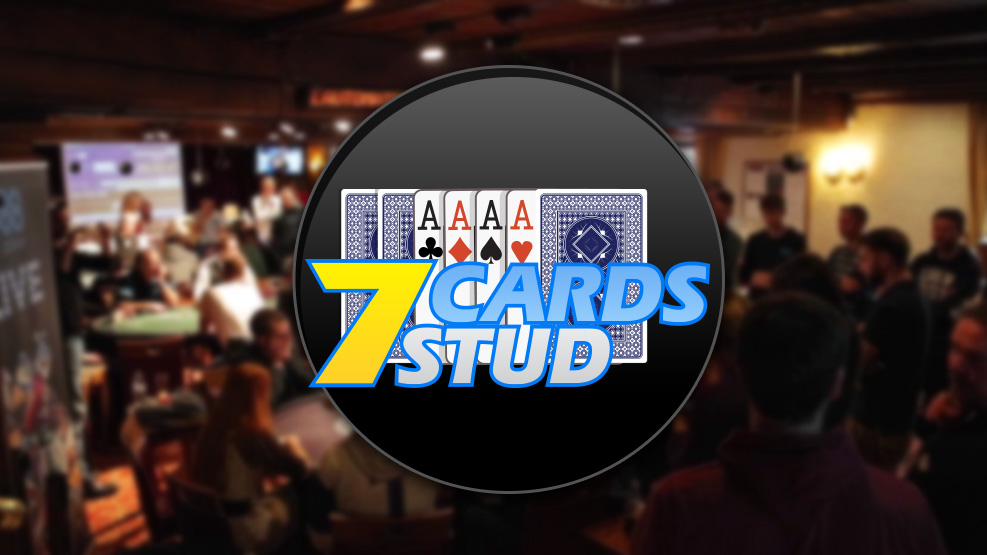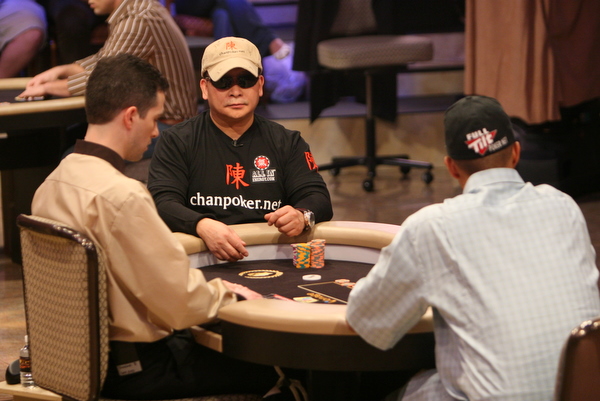- Poker Tournament Heads Up Strategy Tactics
- Poker Tournament Heads Up Strategy Game
- Mtt Poker Tournament Strategy
| National Heads-Up Poker Championship | |
|---|---|
| Created by | NBC Sports |
| Narrated by | Ali Nejad and Matt Vasgersian |
| Country of origin | United States |
| Production | |
| Production locations | Golden Nugget Las Vegas (2005), Caesars Palace (2006 - 2013) |
| Running time | 60 minutes (including commercials) |
| Release | |
| Original network | NBC |
| Original release | 2005 – 2013 (no 2012 event) |
| External links | |
| Website | |
The National Heads-Up Poker Championship was an annual poker tournament held in the United States and produced by the NBC television network.[1] It is a $25,000 'buy-in' invitation-only tournament[2] organized as a series of one-on-one games of no limitTexas hold 'em matches. The participants include many of the world's most successful poker players, as well as celebrities.

The championship was the first poker event to be televised on and produced by a major U.S. television network.[1]
In October 2011, NBC announced that the National Heads-Up Poker Championship would not return in 2012, ending the championship's seven-year run.[3] After a one-year hiatus, the tournament returned for a final time in 2013.[4]The $25,000 buy-in event ran from Jan. 24 through 26 at Caesars Palace, the same venue where the event was held from 2006 through 2011.
In February 2014, NBC announced the National Heads-Up Poker Championship would not return in 2014.
The Heads-Up Championship had been sponsored by online poker companies before Black Friday. The World Series of Poker (WSOP.com) is the new presenting sponsor.[5]
Structure[edit]
The single-elimination tournament is modeled after college basketball tournaments. Players who win a match advance to the next round; the player who wins six matches is crowned champion.
The first round is seeded randomly the night before the tournament begins. Players are divided into four brackets – Clubs, Diamonds, Hearts, and Spades. A participant advances by winning a heads-up match against his or her randomly drawn opponent. The structure of the brackets then determines every match thereafter. The semifinals consist of one player from each bracket, with the winner of the Spades bracket playing the winner of the Clubs bracket, and the winner of the Hearts bracket matched up against the winner of the Diamonds bracket. A best-of-three final match then determines which of the two finalists is crowned champion.
Brief history[edit]
The National Heads-Up Poker Championship is an invitation-only event. In contrast, the World Heads-Up Poker Championship is an open event with a maximum participation of 128 players.
Stay Aggressive. When playing heads-up, the more aggressive player is going to be the one that. A heads-up poker tournament is a series of one-on-one matches with the winner of the match going on to play in further rounds. Each match should last an hour to an hour-and-a-half in length so that you can play four or five rounds of matches in one night. Heads-up games are. Heads-Up Sit & Go’s kick off when a set number of players have registered (i.e. 2, 4, 8, etc.).Head’s Up Multi-Table Tournaments have no late registration and will start – depending on the poker website / venue – with either an even number of players (2, 4, 8, 16, 32, etc.) or an odd number of players, giving some players a first-round “bye.”.
The 2005 event took place at the Golden Nugget Las Vegas between March 4 and March 6. It aired weekly on NBC from May 1 to May 22 with commentary from Gabe Kaplan and Matt Vasgersian.
The 2006 edition took place from March 4 to 6 at Caesars Palace in Las Vegas. NBC began its coverage by broadcasting one part of the opening round on April 16. The semi-final and championship matches aired May 21. Kaplan and Vasgersian returned as commentators.
The 2007 edition was broadcast from April 8 to May 20. Ali Nejad took Gabe Kaplan's spot as commentator due to Kaplan competing in the tournament.
Results[edit]
| Year | Winner | Runner-up | Best-of-three final score |
|---|---|---|---|
| 2005 | Phil Hellmuth | Chris Ferguson | 2–1 |
| 2006 | Ted Forrest | Chris Ferguson | 2–1 |
| 2007 | Paul Wasicka | Chad Brown | 2–0 |
| 2008 | Chris Ferguson | Andy Bloch | 2–1 |
| 2009 | Huck Seed | Vanessa Rousso | 2–0 |
| 2010 | Annie Duke | Erik Seidel | 2–1 |
| 2011 | Erik Seidel | Chris Moneymaker | 2–0 |
| 2012 | no tournament | ||
| 2013 | Mike Matusow | Phil Hellmuth | 2–1 |
See also[edit]
References[edit]
- ^ abNBC Spot in the Cards for Poker Tourney February 2005 article from the Las Vegas Sun
- ^NBC National Heads-Up Poker Championship Inks Four-year Deal with Caesars, a May 2008 article from pokernews.com
- ^'NBC Cancels National Heads-Up Poker Championship'. PokerNews. Retrieved 13 October 2011.
- ^'NBC Brings Back National Heads-Up Poker Championship'. PokerNews. Retrieved 14 January 2013.
- ^'National Heads-Up Poker Championship returns to Caesars Palace'. Retrieved 14 January 2013.
Stripper Stacks
Strippers are cards that are shaped in such a way as to allow them to be easily controlled by pulling them out of the deck, no matter where they are located.
A stripper stack uses this concept, along with carefully chosen cards, to enable a cheat to easily stack the deck in their favour.
A well known example of a stripper stack is the ten-card poker deal, which is a concept often used by magicians.
The Ten-Card Poker Deal
The ten-card poker deal came from the card table; it originally used nine cards and was specifically designed for a 5-card straight poker heads-up scenario.
The cheat would take nine cards from the deck, and cut them in such way that they could be stripped out when required.
Poker Tournament Heads Up Strategy Tactics
In play, after the mark had shuffled, the deck would be passed to the cheat to be cut. The cheat would use the motion of cutting the cards to strip out the nine target cards and place them on top.
Poker Tournament Heads Up Strategy Game
The result of this would be that the nine cards are dealt between the two players, with the mark’s final card being a random card from the deck.
The nine cards consisted of three sets of three-of-a-kind, which we will denote A, B, and C.
So the nine cards are: AAABBBCCC. As such there are a relatively small number of possible outcomes:
The table shows the probabilities that either party will win, given the way the nine cards come out, and whether the random card is helpful to the mark or not.
In most cases the random card is not useful, and the cheat will win. But occasionally the random card will improve the marks hand, and in some cases that may be enough to beat the cheat.
Overall, the cheat will win 96.01% of the time, whereas the mark will only win 3.99% of the time.
The advantages of this particular method of cheating, are that
- It only requires a single “cut” type action, which is built into the game’s procedure,
- It’s done on the opponent’s deal,
- It has a very high success rate.
The main disadvantage is that it requires stripped cards, which need to be put into the game somehow.
Getting Strippers into the Game

Cutting cards to make strippers is not generally something that can be done at the table, which leaves three options:
- Making sure the deck in play has already had the cards doctored
- Switching the deck or the required cards during play
- Cutting the cards from the deck in-play
The first method could be achieved by stocking the local shop with a large number of doctored decks and then insisting that a new deck is purchased before the game begins. Another method would be to have an accomplice who pretends to purchase a deck, but in fact just provides a prepared deck.

Alternatively, the deck could be switched before the game; again with an accomplice that has access to where the decks are stored.
A deck switch could also be done by the cheat during the game, either when they handle the cards to deal, or when given the cards for a cut. In some cases an accomplice may be used to provide a distraction whilst the decks are switched.
Depending on the style of strippers used, it may actually be only the target cards that need to be gimmicked. In this case they could be slowly switched out, one at a time, throughout the night as game play continues.
Finally, the cards in play could be cut, which would require stealing them from the deck, taking them somewhere private to put the work in, and then reintroducing them back into the pack.
A Stripper Stack for Heads-Up Texas Hold’em
Currently, the most popular form of poker is Texas Hold’em, which has quite a different format to straight poker.
Two face down hole cards are dealt to each player, then between rounds of betting, five communal cards are dealt face up on to the table. The players must make the best 5-card hand using their hole cards and the communal cards.
The aim would be to find a set of cards that can be stripped to the top in a single cutting action, and provide a high win rate, when playing heads-up Texas Hold’em.
Mtt Poker Tournament Strategy
The introduction of communal cards means that in many cases the winning hand is not decided until the final card comes down. This means that, selecting a set of 11 cards, such that the river card is random, makes the final result highly variable. So this is not a particularly effective strategy.
If the rules were loosened slightly to allow two ‘moves’, then 7 cards of one suit could be stripped to the top in the first action, and the ace of that suit stripped to the top in a second action. So, instead of ensuring that the mark is dealt a bad card, it’s ensured that the cheat is dealt a good card. In this case, both players would make a flush, and the cheat would win with the ace. This scenario produces a 100% probability of the cheat winning, as the ace high flush can’t be beaten, regardless of which cards are dealt on the turn or the river. However, there is the risk that the cards the mark ends up with are not good enough for them to want to bet on; so whilst the cheat will still win the hand, it may not be the biggest pot.

An alternative would be only controlling the hole cards, risking the fact that the 5 communal cards could completely change the winning hand.
By stripping three aces to the top on the mark’s deal, the cheat will ensure a pair of aces for themselves and the mark will be dealt at least one ace.
There are two advantages to this; firstly, giving the mark an ace may entice them to stay in the hand longer, giving the cheat the opportunity to win more. Secondly, the cheat holds the other two aces, which makes it unlikely that the mark will pair their ace. Furthermore, if the mark makes a hand with their ace, then in many cases the cheat will at least be able to equal the hand, and in some cases beat it.
To illustrate this advantage, the cheat’s pair of aces against any other two random cards, gives the cheat a win rate of 84.93%, the chances of drawing are 0.54%, and losing is 14.52% [results from wizardofodds.com]. Whereas, when the cheat’s aces are up against an ace and any other card, the cheat’s win rate is increased to 88.67%, the chances of drawing is increased to 3.17%, and crucially the probability of losing is now only 8.15% [results calculated with the help of cardplayer.com]. So by giving the mark an ace, the cheat’s chances of winning are increased, as is the chance of the mark making a bet.
Whilst this 88.67% probability of winning is not as high as 96.01% for the straight poker game, or the 100% for the flush scenario, it is still gives a reasonably high guaranteed edge.
To take this further, in The Mathematics of Poker, by Bill Chen and Jerrod Ankenman, a near optimal strategy is given for heads-up play when both player’s stacks are less than 50 big blinds. This strategy suggests that the only two moves in this scenario should be to jam or fold. The details of this strategy are described by a table, which give all possible hole card combinations, and assigns each a value. For the attacker, this value is the stack size in big blinds at which your play should switch from fold to jam. A second table is given for the defender, which dictates at what stack size their strategy should switch from fold to call.
When heads-up it’s common for the order of play to change. In standard multiway tables the player to the left of the dealer posts the small blind, the next player puts up the big blind, and the next player is the first to act. In this manner when heads-up, the dealer would put in the big blind and their opponent would act first. However, the change in play for heads-up means that the dealer acts first and their opponent puts in the big blind.
As the cheat is stripping the cards on the mark’s deal, then if the special heads-up order of play is enforced, the cheat is considered the defender. Whereas, if this change of play is not introduced, then the cheat would be considered the attacker.
Whilst the jam-fold strategy was developed for the alternate heads-up order of play, with the dealer acting first, results were calculated considering the cheat as both the attacker and the defender.
The following graph shows the cheat’s probability of success for a given opponent’s stack size. Where success would mean that the mark did not fold, and the pocket aces won the hand.
The cheat’s actions are clear, with their aces, they should jam if they are the attacker or call if they are the defender. However, the mark’s actions will depend on their stack size and what random card they get with their ace.
The graph shows that the cheat is more likely to succeed if they are the defender, which suggests that the alternate heads-up order of play is beneficial for this method of cheating.
As an example, if the mark has a stack of 40 big blinds, then there is a 60.64% chance of the mark going all-in and the cheat winning the pot.
For a 50% or greater probability of success, the cheat should use this technique when their opponent has less than 42.6 big blinds in their stack. Or 29.2 big blinds if the alternate heads-up order of play is not used and the cheat is the attacker.
Conclusion
The nine-card poker deal was designed for a game of straight poker, and gave the cheat a 96.01% chance of winning the pot. The required cards could be stripped out in a single cutting action, meaning that the play would take place on the mark’s deal.
Applying the same methodology to the game of Texas Hold’em is made more difficult with the introduction of communal cards. But by stripping only three aces, a similar outcome can be achieved; although the win rate drops to 88.67%.
Furthermore, using the near-optimal jam-fold strategy when the players are down to less than 50 big blinds, the cheats probability of success can be determined. These results suggest that the cheat has a greater than 50% success rate when their opponent has a stack of 42.6 big blinds or less.
As a final thought, after the mark calls all-in and the cards are flipped over, they will likely realise that they are a severe underdog. This opens up the opportunity for making a deal and potentially dividing up the pot in a cash game, or deciding finishing positions and prize money splits in a tournament. Making a deal negates the risk of running the board and losing, for both players.
Return to Blog Posts

